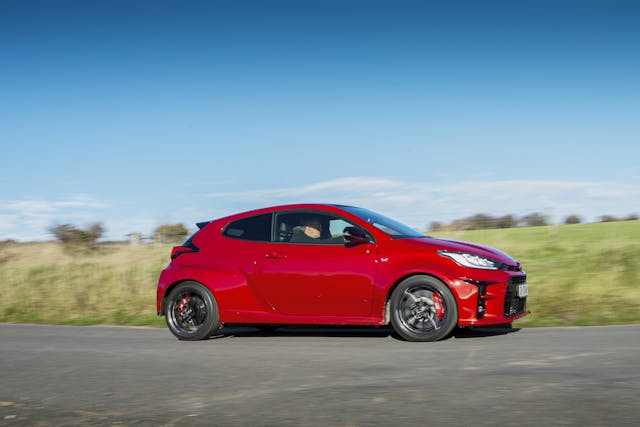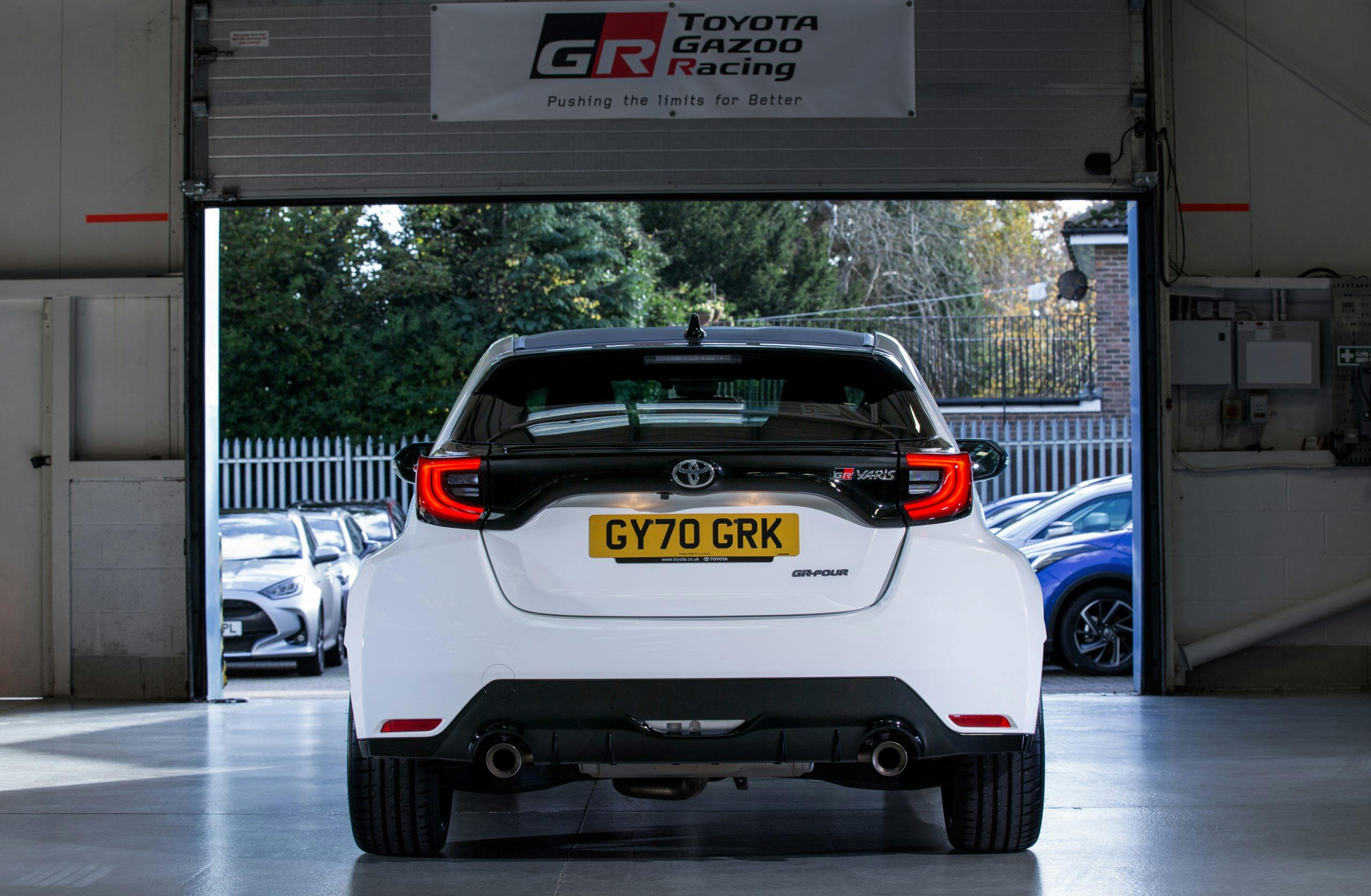Media | Articles
Review: 2021 Toyota GR Yaris
Citroën’s BX 4TC, Ford’s RS200, and possibly Toyota’s new GR Yaris; what do they have in common? They are all homologation specials, built in limited numbers to qualify for top-line racing or rallying, but never actually turned a wheel in competition. Toyota’s dingbat-fast new Yaris is the latest to be a potential victim of the vagaries of motorsports legislation. Then again, cheer up. At least we get to enjoy the car in its road form, in our case on twisty U.K. roads.
And what a machine this hot hatch is.

Akio Toyoda, Toyota’s president and a qualified “master driver,” drove the company’s World Rally Championship (WRC) Yaris rally car in a test session. He screeched to a halt in front of his engineers, swung open the door and said: “Build it.”
No pressure there, then. A WRC car is designed to be thrashed for three solid days across roads you wouldn’t walk on, and it could all but fall apart as it takes the checkered flag. No 100,000-mile/five-year warranty, no Apple CarPlay integration, no maximized luggage space nor rear-seat access for this supermini hatchback. This was planned to be the nearest thing to driving a fire-and-brimstone spitting WRC car as possible to let loose on the unassuming public.

Roughly based on the fourth-generation Yaris hatchback, the car is badged as a Gazoo Racing model—the third-such GR sports car to arrive after the reborn Supra and another Yaris, the GR MN, which was based on the face-lifted third-generation model. The development team was a skunkworks to reckon with, headed up by chief engineer Naohiko Saito, with four-time World Rally Champion Tommi Mäkinen (who is now head of Toyota Gazoo Racing) and a sizeble team of engineers, designers, and drivers including works drivers Jari-Matti Latvala and Kris Meeke. In theory, this is the kind of car that has a blank check, but no one thought to tell Toyota’s accounting office, and Saito-san tells of frequent phone calls questioning the cost of carbon-fiber polymer, Toyota’s first bespoke 4×4 drivetrain in 20 years, turbo engines with a main shaft running on ball bearings, and hand-built production.
Marketplace
Buy and sell classics with confidence

Built at the Gazoo Racing facility at Toyota’s Motomachi factory in Japan, the GR Yaris three-door bodyshell has a carbon-fiber polymer roof, aluminum doors and hood, and an olefin-polymer rear bumper. It might be designed to bring home the hardware from the forested hills of WRC rally stages, but the dimensions are pure economy hatchback: 157.2 inches long, 71 inches wide, and 57.3 inches high. It weighs between 2822 and 2888 pounds depending on the specification, which is about 10 percent lighter than the standard five-door Yaris and boasts a wider rear track and double-wishbone rear suspension in place of the standard twist beam. Up front are MacPherson struts. If you are still wondering just how special this car is, it shares just seven parts with a standard Yaris: headlights, door mirrors, rear-lamp clusters, and the shark-fin roof antenna. It’s stiffer by some margin, having been put together with 4175 spot welds and 139 inches of structural adhesive, which is 259 spot welds and 57.5 inches more glue than a conventional Yaris.
Toyota would have had to build 25,000 models in a single year to qualify the GR Yaris for use in the WRC, but recent events have meant that the FIA has allowed teams to continue with the cars that they currently use, prior to a major change to common-safety-frame, hybrid-engined kit cars in 2022.
“I would have liked it to be on the rally stage,” comments Saito with a wry smile.

The three-cylinder engine displaces 1618 cc and has nothing in common with anything else in the Toyota canon. As well as a special single-scroll turbo, the engine has four valves per cylinder actuated by chain-driven, overhead cams, with gasoline delivered via direct and indirect fuel injection. It punches out 257 hp at 6,500 rpm and 266 lb-ft of torque at 3000 rpm. For better weight distribution, the mill is mounted 0.8 inches farther back in the frame than in the standard car.
Just how did Saito-san get it to last in Toyota’s furiously tough sign-off process and meet the standard production warranty?
“We broke a lot of engines,” he says, dryly.

For lightness, the six-speed manual transmission is the only option, and the all-wheel-drive system takes power from the front-mounted transverse engine and gearbox back to the rear via a multi-plate, oil-bath clutch. The rear differential is set up to drive the rear wheels slightly faster than the road speed, so the clutch can be closed fully to over speed the rear wheels, steering or sliding the rear of the car. Torsen mechanical limited-slip differentials at the front and rear are options in the Circuit Pack, which also gives you Michelin Sport Pilot tires on 18-inch forged wheels. Three driving modes are offered, the first with 60/40 percent front/rear-drive for city driving, the second with 30/70 percent rear bias for more spirited driving, and the last with 50/50 percent split for loose surface stage rally driving or snow. Brakes are four-piston aluminum calipers at the front, with twin-piston units at the rear. Top speed is limited to 143 mph with 0-62 mph in 5.5 seconds, which is quicker than a standard Porsche Macan. The car delivered 21.3 mpg on a twisting country road drive.

To look at, this is a Yaris after it’s been made over by the FBI witness protection program. The front end full of air intakes harks back to a late-’80s look when cars such as Nissan’s Pulsar GTiR, Ford’s Escort Cosworth, and Lancia’s Delta Integrale set the rally world alight.
You sit quite high in the body, just as drivers do in professional rally-car preparation where observation of the stage is crucial. The suede-trimmed seats cosset and the steering wheel and gear lever are set close to the driver. It takes a little while to get a good driving position, but it’s worth it once you do. The pedal box is roomy, with enough space to heel-and-toe gear changes, though Toyota’s IMT electronic circuitry will automatically rev-match downshifts if you prefer. All around the interior are Toyota switches, analog dials, and a center touch screen, which looks like a crash-landed iPad. It doesn’t exactly scream “rally car,” but it’s nicely put together and the materials are pleasant to the touch. And yes, Apple CarPlay and Android Auto are standard, as is the full suite of Toyota camera-and-radar safety systems that include emergency braking assist and lane-keeping.

There’s space enough. Decent-sized door pockets and little trays abound, so that up front at least, this is a practical car. Try to climb in the back, though, and you’ll find that head and legroom are severely limited. And while the seat backs tilt onto their bases 60/40 percent, the six-cubic-foot standard trunk is about big enough for a couple of motorsport helmets. Spare wheel? Lift the trunk floor and you’ll find just the battery, moved there for better weight distribution.
Start up the three-pot and it first warbles like a washing machine. Careful, now—this is a proper motorsport mill and its lack of rotational inertia means it’s quite easy to stall when pootling around town. Rev it and the artificial enhancement gives the impression the washing machine’s on full spin with a couple of bricks inside, but my stars, this car has some get up and go. Stand on it and the bluff snout dashes for the horizon, with the body giving a bit of a shimmy on the squishy Michelins at every gear change. Make no mistake, the car is enjoying this. No Yaris should be this fast, and the drivetrain feels unburstable—particularly the transmission, which is heavy, direct, and clicks into gears faster than you can move your arm. Even at low speeds, the GR Yaris feels beefy and fun.

The ride isn’t as darn awful as you’d expect, either. It deals with big road bumps and potholes in a manner that speaks of very expensive damping. Unlike hot hatchbacks of yore, the Yaris tracks straight and true even when the Torsen diffs of the Circuit Pack are snouting down the road in search of grip like bird dogs on a leash. On broken-edged roads, there’s a fair bit of head tossing from side to side, but at no time does it feel skittish or frightening. The steering is nice and weighty and it loads up progressively, though it’s a tad light on feedback.
With a chassis set up designed to feel as neutral as Toyota would dare for a street car, the GR Yaris will gently nose-on understeer into a turn as long as you don’t provoke it. That’s the right and proper way to engineer a 257-hp, AWD hot hatch on a wheelbase just a whisker over 100 inches. Do anything in a corner, however, and it’s like showing a spaniel a tennis ball; Yaris wants to play. Like the great rally cars of yore, the car responds to throttle input like nothing else you can buy. Plant your right foot and it tightens its line round a corner, ease and it pushes outward, lift off and the back starts to unstick. Then, you can left-foot brake it to slow and balance the chassis through the turn. Those brakes, by the way, are stunningly powerful with a great pedal progression.

Even on a public road, all those responses are there, albeit more muted and slower. Eco mode is for shopping runs, but Sport mode feels most natural. Dial in Track and the car gets nervous as the front and rear tires fight each other, demanding a corner to collectively gobble up. After a hard run in Track mode, you’ll welcome Eco on your way to the shop to collect some salve for your aching cheek muscles sore from power grinning.
The GR Yaris is a wonderful, hellacious little car that reminds us, as Shakespeare wrote in As You Like It: “all the world’s a stage.” The tragedy, then, is that the GR Yaris isn’t coming to North America, but it sure as hell establishes the bar in Gazoo Racing showrooms worldwide.
2021 Toyota GR Yaris Circuit Pack: £29,995 ($29,593)/£33,495 ($44,213) as tested
Highs: Hellsapoppin’ performance, with chassis adjustability that defies belief. If this isn’t a pure-bred rally car for the road, then it’ll have to do.
Lows: Some will find the driving position too high, there is much to switch off before the real fun hits, not coming to the United States.
Summary: The tiny Toyota that turns the whole world into a private rally stage.






















































